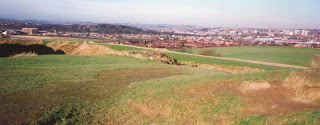The Battle of Wakefield took place on December 31st, 1460,
and this site in Yorkshire was the very first visit we made on our 15th century tour, on
a cold but sunny day in January 1999.
In June 1460, the Yorkists had defeated the Lancastrians at
Northampton, and King Henry VI had been captured. He was then forced to accept
Richard, Duke of York, as the next in line to the throne.
Henry’s queen, Margaret of Anjou, who had retreated to
Wales, refused to see her son disinherited, and gathered the Lancastrian forces
at Pontefract in south Yorkshire. Meantime, York and his son Edmund moved to
Yorkshire, occupying York’s castle at Sandal, just outside Wakefield, while
Warwick remained in London to safeguard the custody of Henry VI.
A Yorkist foraging party was ambushed at Wakefield Bridge,
and the survivors raced for Sandal Castle, pursued by the Lancastrians, who
amassed in the area between the castle and the river Calder. Since they seemed
to be trapped there, York decided to attack.
 |
| View of the battlefield from Sandal Castle |
Unfortunately, he didn’t realise that the right and left
flanks were hidden, and of course they came out of the woods and annihilated
the Yorkists. Richard of York and his son Edmund were both killed, and
York’s brother-in-law, the Earl of Salisbury was also captured and executed.
Their heads, festooned with paper crowns, were hung on the Micklegate Bar in
York.
 |
| Monument marking where Richard of York was killed |
Sandal Castle must have been must have been an impressive
construction in the 15th century. The large motte on which the keep stood is
still visible from Wakefield Bridge, and there is evidence of an
extensive wall and other buildings, as well as two moats surrounding the
castle.

I have been there :)
ReplyDeleteSomewhere else for me to visit.
ReplyDeleteAnother interesting spot full of history!! Awesome post!
ReplyDeleteKathy
http://gigglingtruckerswife.blogspot.com
I would love to explore it!
ReplyDelete